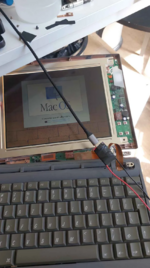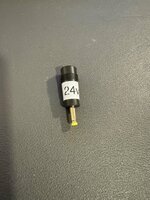I just finished re-celling a few iBook G3 battery packs. While this will allow me to use them without being plugged in, and it certainly maximizes the portable nature of these machines, I had a couple thoughts:
1. I do have concerns about the safety of home built packs. I read up on it, bought quality cells, used a spot welder to not heat the cells during assembly. However, I still am nervous as I tried to cram all the cells, wiring, and boards back into the original shells.
2. Eventually these cells are going to go bad. At which time, I would need to re-re-cell them. I also have dozens of laptops, each with different batteries and power bricks. Trying to maintain battery health by charging and discharging individual machines regularly is best, but I know from experience I simply don't do this.
So, it got me thinking about an ideal solution. I thought of a couple of things that I believe would be good:
1. Being able to use the plethora of cheap and replaceable USB-C battery packs on the market. People could chose a capacity that suits their need for how much portability is necessary.
2. Having a solution with USB-C input (USBPD) would mean you could also use USB-C power adapters for use when an outlet is available.
3. The solution would not use the battery bays of the laptops, so it wouldn't be ideal from an original look standpoint, but I think the flexibility would be a good trade-off.
4. It would be amazing if the solution offered an easy way to switch between voltages (a manual screw in a buck converter would not be user friendly) and plug types for most or all of our vintage laptops (it would be ideal to prevent sending 24v to the PB100 cable). I know more recently with MagSafe things got more standardized, but it would be very cool to have a handful of cables coming out, along with a dial or toggles to switch between the machine being used.
So imagine you have you Mac Portable, you could have a device that takes USBPD in, you set the output to the Portable / PB100 cable, and it drops the 20v from the USB-C to a 1.5A, 7.5v output. Then, with the same device, you could change the settings to PB 1xx and it bumps it to 2A, but with the same cable. Then, with the device to PB 5xx and it provides 16v to the weird 4 pin connector (only to the power, not to the BAT pins, likely). Rinse and repeat for all the connectors up to MagSafe.
I say this, but I don't have a background in EE so I have no idea how hard / easy it is to create a board with simple components that could be DIY and offer this ability to switch between voltages with adjustable current. I really think it would be cool to make a PCB with the USB-C input on one side, components in the middle with a method for selecting the output, and all the custom outputs on the other (with an LED to show which output is active). A 3d printed case to package it all up and I feel like you could really help prolong the usefulness of these laptops given batteries are, to me, the hardest things to keep in a usable state.
I know many of the connectors are readily available for these DC inputs, so that seems to be source-able. How complicated of a PCB design would it be?
Any other thoughts on feasibility here?
1. I do have concerns about the safety of home built packs. I read up on it, bought quality cells, used a spot welder to not heat the cells during assembly. However, I still am nervous as I tried to cram all the cells, wiring, and boards back into the original shells.
2. Eventually these cells are going to go bad. At which time, I would need to re-re-cell them. I also have dozens of laptops, each with different batteries and power bricks. Trying to maintain battery health by charging and discharging individual machines regularly is best, but I know from experience I simply don't do this.
So, it got me thinking about an ideal solution. I thought of a couple of things that I believe would be good:
1. Being able to use the plethora of cheap and replaceable USB-C battery packs on the market. People could chose a capacity that suits their need for how much portability is necessary.
2. Having a solution with USB-C input (USBPD) would mean you could also use USB-C power adapters for use when an outlet is available.
3. The solution would not use the battery bays of the laptops, so it wouldn't be ideal from an original look standpoint, but I think the flexibility would be a good trade-off.
4. It would be amazing if the solution offered an easy way to switch between voltages (a manual screw in a buck converter would not be user friendly) and plug types for most or all of our vintage laptops (it would be ideal to prevent sending 24v to the PB100 cable). I know more recently with MagSafe things got more standardized, but it would be very cool to have a handful of cables coming out, along with a dial or toggles to switch between the machine being used.
So imagine you have you Mac Portable, you could have a device that takes USBPD in, you set the output to the Portable / PB100 cable, and it drops the 20v from the USB-C to a 1.5A, 7.5v output. Then, with the same device, you could change the settings to PB 1xx and it bumps it to 2A, but with the same cable. Then, with the device to PB 5xx and it provides 16v to the weird 4 pin connector (only to the power, not to the BAT pins, likely). Rinse and repeat for all the connectors up to MagSafe.
I say this, but I don't have a background in EE so I have no idea how hard / easy it is to create a board with simple components that could be DIY and offer this ability to switch between voltages with adjustable current. I really think it would be cool to make a PCB with the USB-C input on one side, components in the middle with a method for selecting the output, and all the custom outputs on the other (with an LED to show which output is active). A 3d printed case to package it all up and I feel like you could really help prolong the usefulness of these laptops given batteries are, to me, the hardest things to keep in a usable state.
I know many of the connectors are readily available for these DC inputs, so that seems to be source-able. How complicated of a PCB design would it be?
Any other thoughts on feasibility here?


